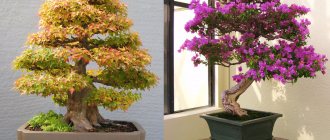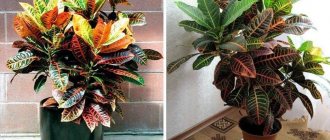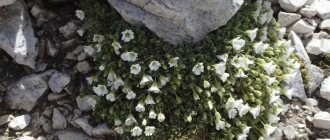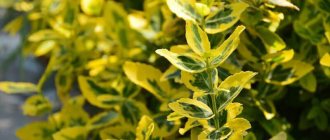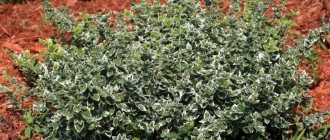In spring, it looks like an ordinary shrub (less often - in the form of a tree) with unsightly small flowers. True, it is quite dense, branched and with a beautiful spherical crown. In the summer, with the appearance of red fruits with large poisonous orange seeds, it involuntarily begins to attract the eye. It reaches the apogee of its luxury closer to autumn, when the leaves suddenly turn it into a brightly burning fire with rich scarlet flames. This is exactly how European euonymus, an ornamental plant that has recently been increasingly used in landscape design, transforms during the season.
General description of the plant
European euonymus is a bush or deciduous tree up to 3 m high , sometimes up to 5–8 m. The branches are tetrahedral; there are no warts, as in some varieties.
Places of growth
- Caucasus.
- Crimea.
- European part of Russia.
Note! Some specimens reach an age of 50 years or more. In the Askania-Nova Biosphere Reserve (Ukraine), an euonymus grows with a crown diameter of 6 m, a height of 4 m, and the age of the record holder is 62 years.
Flowering period – April – June . Small greenish-white flowers reach 10–12 mm.
The fruit is a four-plate capsule of a rich purple hue. After the fruits ripen, small seeds remain on thin threads.
The high decorativeness of leaves and bright fruits in the autumn explains the popularity of the shrub (tree) in landscape design. This variety of euonymus is often placed along hedges and fences .
Red Cascade
One of the most beautiful and popular varieties of European euonymus is Red Cascade. A rather large shrub, which in adulthood reaches a height of about 4 m. The size of its crown is also impressive: it is about 3 m wide. In the first years after planting, it is a small, narrow and straight bush. But the older the shrub gets, the more its crown expands. During the summer months, its dense foliage is dark green, and with the onset of September it becomes very elegant, with a predominance of bright yellow, purple, and crimson shades. The shrub begins to bloom in May, but at this time small, inconspicuous flowers of pale yellow color do not attract much attention. But in the autumn-winter period everything changes: on the Red Cascade hang dark red, pink, orange lanterns (leathery fruits) of extraordinary beauty.
Kinds
Euonymus has several varieties:
- unique winged;
- dwarf - ideal for growing at home;
- unpretentious warty;
- Japanese.
Planting seedlings
When selecting a place for planting seedlings, it is necessary to take into account that the plant does not like stagnant water and does not grow well in acidic soils. For strongly growing varieties, a spacious place is required away from plantings and buildings. Planting dwarf species in large boxes or well-permeable containers will allow you to bring them into a bright, cool room or winter garden with the onset of cold weather, maintaining the temperature within 5-10°C. Early spring or mid-autumn is suitable for planting euonymus.
Euonymus seedling
Sequence of work:
- A hole is dug, the width and depth of which should be twice the size of the root system of the bush.
- At the bottom of the pit, drainage is created, consisting of sand, expanded clay or broken brick, then humus or mature compost is poured.
- The soil and nutrient layer are moistened, then the seedling is placed on the bottom and covered with soil, compacting the top layer.
- The surface of the earth is watered.
Advice. To ensure that moisture from the soil evaporates more slowly, the surface should be mulched with peat; instead, you can also use crushed tree bark. From time to time, the mulch layer can be updated by adding peat. This will prevent the formation of a soil crust, which promotes increased evaporation of moisture, and will make it more difficult for weed seeds to enter and germinate.
Photo
In the photo below you can appreciate the appearance of the European euonymus:
Varieties and varieties of euonymus
The genus Euonymus is part of the Euonymus family. Some types of euonymus are shrubs, others are trees. They can be evergreen or deciduous. The most attractive feature of the plant, which is demonstrated in the photo, is the variety of autumn colors of the leaves, simultaneously combining red, yellow, white, orange, purple, and burgundy shades.
Euonymus in autumn
The bright fruits cannot be eaten due to the presence of toxic substances, but their unusual shape (pink lanterns with dangling earrings) is a wonderful decoration for the garden in late autumn. During frosts and snow blizzards, birds wintering in our latitudes feast on the fruits. Euonymus is also valued as a medicinal plant, and planting it next to apple trees allows you to fight one of the most dangerous pests of these fruit trees - the codling moth.
Blooming euonymus warty
The most widespread varieties of euonymus include the following:
- Fortune's euonymus
is a low evergreen shrub brought from China by the English scientist R. Fortune. The height of this evergreen frost-resistant shrub does not exceed 50 cm. It has dark green leaves with a white or yellow border along the edges, as seen in the photo. The fruits of the plant are less bright compared to tall species, but quite impressive. In the climate of the middle zone, this variety rarely blooms and bears fruit;
Euonymus Fortune
- Euonymus warty
is a deciduous shrub common in the mountainous regions of Russia, Ukraine, central and south-eastern Europe. It is distinguished by its unpretentiousness, frost resistance, and high decorative qualities. The bushes reach a height of 1.5 m, the branches have thickenings (warts), are characterized by slow growth, adding only 10-12 cm annually;
Euonymus warty
- European euonymus
- often found in deciduous forests of the central and southern regions of Russia, grows in Western Europe, Asia Minor, and the Balkan Peninsula. Another name for this species is Bruslin's euonymus, in America it is a spindle-shaped tree. The plant reaches a height of 2 to 8 m and can withstand up to 15 degrees of frost;
European euonymus
- Japanese euonymus
is a heat-loving variety from Japan that cannot withstand temperatures below 5 degrees. It can be grown in an apartment or a heated winter garden. The plant may have shiny green or variegated leaves, and at home its height does not exceed 0.5 m. Some natural species of Japanese euonymus grow as vines 5-7 m long;
Japanese euonymus
- Euonymus dwarf
is a rare shade-tolerant species that reaches 1 m in height and prefers carbonate soils. The shrub is very decorative thanks to its fine-toothed leathery leaves and yellow-green fruits. When planted densely in a row and regularly trimmed, it is well suited for creating a beautiful border. When grafted onto Japanese euonymus, you can obtain specimens with a weeping crown shape;
Euonymus dwarf
- Euonymus winged compactus
is a shade-tolerant deciduous plant 1-2 m tall, imported from the Far East. The branches have a rounded shape with edges formed by longitudinal growths, the dark red fruits are shaped like boxes, and with the arrival of autumn the leaves acquire a bright red color, giving the plants a special elegant look.
Euonymus winged compactus
Planting and care at home
European euonymus has taken root well in gardens and parks. Urban conditions with increased gas pollution are not scary for the plant.
Gardeners know that if the conditions are met, euonymus blooms profusely and delights with bright leaves in the fall. A beautiful openwork crown with or without numerous flower tassels is highly decorative.
Important! The only caveat is that for increased decorativeness, a sufficient area of open space is required.
Care after purchase
Bring the seedlings home, place them in a cool place : let the roots rest slightly. Be sure to save some of the native soil in which the young bush previously grew. Make sure the ground is moist.
Trimming
The crown is formed in early spring or at the end of fruiting . Euonymus responds to pruning with rapid growth of young shoots.
The main shape of the crown is ellipsoidal or cone-shaped.
Gardeners often form a standard tree.
Important! Partial sanitary pruning is permissible during the growing season only for serious indications.
Carefully pinch the tops and remove weak shoots.
Watering
Euonymus prefers moderate soil moisture . With excessive watering, rotting of the roots and poor growth were noted. tolerates dry periods well .
Landing
The plant is planted in the ground in the spring ; autumn planting is less common. Choose a sunny place: in the shade, bruslina feels worse, the leaves lose their decorative properties.
How to proceed:
- dig a hole so that the root collar is at ground level;
- the size of the depression in the ground is one and a half times larger than the root system of the seedling;
- pour 10 cm of sand onto the bottom;
- add a mixture of peat, sand, turf soil (2:1:1);
- next layer – mineral fertilizers – 100 g plus slaked lime – 200 g. Optimal pH level – no more than 7.5;
- sprinkle the roots, tamp lightly, water moderately.
Note! After planting, the first four days require daily watering in moderate amounts.
Many gardeners plant a spindle tree not far from fruit plants: pests move to the ornamental leaf plant, forgetting about the apple trees. Maintain a distance sufficient for the free formation of the crown of neighboring trees or shrubs.
Transfer
The time has come to transplant the strong young seedlings into open ground.
The euonymus is transplanted to a permanent place for the 3rd year .
Choose a calm spring day when the soil is warm enough.
Planting rules are the same as for adult plants.
Caring for European euonymus
European euonymus is not demanding in care. The main thing for him is good pruning, proper watering and timely application of fertilizers, then the plant will delight you with its decorative qualities.
Watering
In the first week after planting, watering should be frequent. Further, the bush needs a large amount of water only during dry periods in the summer. If there is excess moisture in the soil, the roots of the plant may begin to rot. After rain or watering, the soil around the trunk should be loosened and sprinkled with peat mulch.
An adult specimen needs 40 liters of water per square meter of area, and young animals, whose root system is actively forming, experience even more abundant thirst. The roots of the euonymus lie at a depth of up to half a meter, and when watering it is important that the soil gets wet to this or even greater depth. In the dry autumn, before the onset of cold weather (approximately at the end of October), it is worth watering the plant generously, otherwise it may freeze in the winter.
Top dressing
European euonymus is not one of the picky plants, but it needs periodic feeding - this has a positive effect on the decorativeness of the foliage. It is recommended to feed the plant three times during the growing season.
The first feeding occurs in the spring, at the stage of flower bud formation. At this point, you should add organic matter, be it cow manure or bird droppings. Both fertilizers are diluted with water, the proportion for manure is 1:10, and for litter – 1:20.
Repeated feeding is necessary for an already flowering plant, which at this stage needs a large amount of different minerals. Accordingly, complex mineral fertilizer is applied.
When the euonymus has finally bloomed and has begun to form fruits, a third fertilizing is applied, aimed at increasing the number and color of the bolls. For the third time, phosphate-potassium fertilizers are used, which are applied to the tree trunk circle.
To ensure that the fertilizing reaches the root system in its entirety, fertilizer is applied immediately before watering.
Mulching
Mulching partially helps make watering less frequent - a layer of mulch prevents moisture from evaporating too quickly. Mulch also has benefits in other areas, in particular, it slows down soil subsidence due to high humidity and prevents weeds from growing. At the same time, the soil in which the crop grows must be loose - this is the only way the root system of the bush can fully breathe.
Crown trimming
The first pruning of the year is carried out in early spring - even before active sap flow begins inside the plant. The gardener's job is to remove dead and broken branches. Thanks to this, minerals are redistributed in favor of dormant buds - the tree produces new shoots and generally looks fresher.
After pruning, the bush forms many young shoots. The top of the shoots is pinched so that the bush grows in the desired direction. During sanitary pruning, weak and damaged branches are removed.
For ornamental crops, crown molding is important, especially since European euonymus can be used to make a neat spherical bush or standard tree, and experienced gardeners often create classic cones and ovals based on the euonymus crown. During the season, individual branches can grow and spoil the decorative appearance of the crown, so minimal ongoing correction is required.
Transfer
Young seedlings are moved to a permanent place in the 3rd year. This is done in the spring in calm weather, when the soil has warmed up. Transplanting euonymus cannot be combined with pruning. It is better not to touch bushes that are more than 7 years old. Such plants do not tolerate transplantation well. If the need arises, the bush is dug up in the spring with a large lump of earth and carefully moved to a new place.
Preparing for winter
European euonymus is a frost-resistant plant, so it can withstand frosts down to -25°C without shelter in snowless winters. Experts recommend spreading mulch around the trunk in late autumn and covering it with leaves or straw on top to prevent the roots from freezing. Young plants (up to 3 years old) need complete shelter. The seedling must be lightly tied with twine and covered with any covering material, for example, agrofibre or burlap.
If the ends of the shoots are damaged by frost, then you just need to cut them off in the spring and the bush will quickly regain its strength.
Temperature and lighting
In the shade, the decorative quality of the leaves decreases and the growth of the bruslin deteriorates. The ideal location is open areas with sufficient access to sunlight.
European euonymus loves warmth, but tolerates winter cold well. Winter hardiness has made it possible to plant bruslina in different regions of the European part of Russia.
Growing
Euonymus requires sufficient light , neutral or slightly alkaline soil, and regular aeration. Clay soil, in addition to mineral and organic fertilizers, requires regular application of sand.
Immediately after watering, sprinkle the tree trunk circle with peat mulch. In autumn and spring, fertilize with mineral fertilizers once .
Important! The spindle tree does not tolerate salinity. Monitor the acidity of the soil, maintain a pH level of 6.6 to 7.5.
History and legends about the appearance of the plant
Many legends are associated with the bright woody plant. Offended by the human race, the sorceress decided to take revenge on the offenders and grew a dangerous, poisonous Euonymus bush. Looking at the suffering of people, the witch took pity on them and replaced her anger with mercy. She made the fruits of Euonymus medicinal, she herself turned into a small robin bird and introduced everyone to the unique properties of the berries.
Euonymus (Winged Dwarf)
Another legend attributes the creation of the plant to the ancient Roman goddess Flora. While walking through the forest, she lost her earrings and a brooch with a floral design. Beautiful Flora was upset, but did not look for decorations. She made them poisonous and endowed them with unprecedented beauty. The Latin name of the genus is Euonymus, meaning “alluring beauty.” The openwork crown especially attracts attention during the flowering period - in the fall. A single leaf has up to six colors: orange, pink, red, white, yellow, purple. From mid-autumn, the red palette becomes dominant. Bright fruits attract attention before the onset of cold weather.
In the natural environment, representatives of the family are found in deciduous and mixed forests. You can get acquainted with the plant in different parts of the world, with the exception of the northern regions. Representatives of the species feel comfortable in temperate, tropical and subtropical climates.
Euonymus fusaggine
In 1931, the Soviet professor and botanist Bosse discovered gutta-percha, a valuable resin, in the bark. Today, the plant is used not only to decorate garden plots, but also in certain industries.
Reproduction
The main type is the vegetative form :
- root suckers;
- dividing the bush;
- green cuttings.
Propagation by seeds requires more attention and patience. Under natural conditions, most of the seeds will germinate only in the second spring. Gardeners stratify seeds to speed up the germination process.
Stratification duration:
- first stage – 3–4 months at temperatures from +10 to +12 C;
- the second stage is 4–5 months, the temperature drops to 0…+3C.
Note! Seeds are sown in a specially designated place. The ideal soil composition is turf, sand, humus, leaf soil (1: 1: 2: 4).
In cool weather (autumn and spring), a layer of peat mulch is required. In winter, be sure to cover the young shoots with spruce branches.
Use in the garden
European euonymus has a dense root system, so it is planted on slopes to retain soil.
Well suited for decorating fences and walls of buildings. Due to its good response to cutting, it is used for topiary and also for creating hedges.
Can serve as a background plant in a mixed flower garden. Combines well with vegetation that has yellow or green leaves in autumn.
Despite its undemanding nature in terms of care and growing conditions, as well as its fairly high decorative value, European euonymus has not yet received the deserved attention of gardeners.
When, with the onset of cool nights, the crown of the euonymus changes its outfit, it turns, as if by magic, into a real work of art. The leaves become pink, carmine red, raspberry, purple, burgundy. A real fireworks display of colors. And once you see how amazingly bright fruits painted in purple tones look against the background of white snow, you will no longer remain indifferent.
Benefits and harms
The spindle tree is used:
- in landscape design, as a soil-protective plant;
- herbalists, herbalists;
- high-quality wood is needed for making organ pipes , for wood carving, and engraving work;
- fatty oil is the basis for the production of high-quality natural soap ;
- the bark accumulates a high percentage of rubber-like gutta-percha;
- seed roofing, a decoction of the pods, is used to make paint ;
- loose charcoal from wood is used in inking pencils;
- The cake is sent to feed livestock .
Important! Bruslina does not harm neighboring trees and shrubs. One caveat - the carmine-red fruits are poisonous .
Medicinal properties
European euonymus is not only known for its decorative properties, it also has practical benefits for humans. Its wood is used for various crafts, the bark is used in the production of some textiles, and the oil from the seeds is used in soap making.
In addition, its above-ground part, due to its wide chemical composition, is used in folk medicine. A decoction of euonymus bark is used for diseases of the heart and blood vessels. With the help of fruits they fight low blood pressure, and they can also increase libido. The leaves will help with fungal skin diseases.
Euonymus has insecticidal, antimicrobial, diuretic, anthelmintic, expectorant, laxative and antiparasitic effects.
It is important to remember that taking large doses of the decoction causes inflammation of the small intestine, vomiting and hemorrhoidal bleeding. This plant is completely poisonous.
It will be useful to read:
Caring for Euonymus warty The original plants that adorn our garden plots are not only exotic “overseas guests”. There are such…
Diseases and pests
Euonymus attracts garden pests. Gardeners often use timber as a trap for harmful insects.
The spindle tree is often inhabited by:
- apple moth;
- hawthorn;
- aphid;
- caterpillars;
- spider mite;
- mealybug.
Major diseases
- trunk rot is a dangerous fungal disease that is difficult to treat. For prevention in the spring, treat the plant with 1% Bordeaux mixture. If the bruslin tissue is severely damaged, do not hesitate to burn the plant, otherwise the fungus will spread to healthy shrubs and trees;
- Powdery mildew is another disease that affects the spindle tree. Fungicides are required for control: Topaz, Previkur, Fundazol. The frequency of treatment is every other day until the disease is eliminated.
Subtleties of care
- Watering . European euonymus is a fairly drought-resistant plant, so it needs moderate watering. But do not let the soil dry out. It is necessary to water abundantly after planting, in dry weather, and also after applying fertilizing.
- Loosening the soil . In order for air to flow better to the roots of the plant, careful loosening of the soil is necessary. Also, do not forget to remove weeds periodically.
- Fertilizer . It is better to fertilize twice. In early spring and summer - complex fertilizer. And in late autumn, during digging, we add slaked lime (300 g/sq.m).
- Trimming . Euonymus is a shrub that responds very well to pruning and trimming. With the onset of spring, before the sap begins to flow, it is necessary to remove all frozen, dry, diseased and inward-growing branches using sharp garden tools. And in the fall you should start forming the crown. After shearing, the euonymus quickly produces new growth and becomes more luxuriant. To enhance branching, it is recommended to pinch out young shoots in the spring.
- Wintering . European euonymus is a fairly frost-resistant species. It can withstand severe frosts (up to -25 degrees) and even without snow. Therefore, it does not need shelter for the winter. Before the onset of frost, it is enough to mulch the root circle well and cover it with dry leaves, pine needles or straw. However, young plants (one- and two-year-olds) must be completely covered. To do this, you can tie them and wrap them with agrofibre.
- Diseases and pests . Euonymus has quite a few pests, namely: scale insects, aphids, mealybugs, apple moths, and mites. If you notice the first signs of damage (twisted or damaged leaves, bending of young shoots), immediately treat the bush with an appropriate insecticide. Among the diseases, euonymus is susceptible to powdery mildew and trunk rot. Interesting fact: if you notice caterpillars on an euonymus, then most likely there won’t be any on an apple tree growing nearby.
As you can see, euonymus, planting and caring for it do not require much effort. It is very winter-hardy, is not afraid of drought and is well suited for urban conditions, as it is gas-resistant.
It will be useful to read:
Japanese euonymus on the site For tireless creators of beauty, this article will be useful, since in it we will look at an unusual species...
Euonymus fruits: poisonous or edible
The genus Euonymus has about 142 species. Most of them contain substances that are toxic to humans. 20 species grow in Russia. The most common are warty and European (bruslina). Poisonous elements are contained in all parts of the euonymus, including the fruits. They taste sweetish. They leave an unpleasant aftertaste after eating.
Chemical composition
When studying the composition of euonymus fruits, many substances were discovered that have a variety of effects on the human body.
Did you know? Durian has the most unpleasant smell among fruits in the world. Due to its bad aroma, it cannot be transported in transport or on airplanes.
Among them:
- avoniside, the cleavage of which produces digitoxigenin, rhamnose and glucose;
- triacetin - can increase blood pressure;
- alkaloids;
- fixed oils;
- gutta-percha.
Symptoms of euonymus poisoning
When consuming the fruits, a person may experience symptoms that are characteristic of gastrointestinal poisoning.
Among them:
- nausea;
- vomit;
- diarrhea.
Chills, weakness, convulsions, and disturbances in heart function may also be observed. A person who has such symptoms must immediately provide first aid: induce vomiting, rinse the stomach, give an enema or a laxative, give activated charcoal or another sorbent. The poisoned person must be given complete rest . It is important to give him plenty of fluids and saline solutions to avoid dehydration. If convulsions or cardiac problems are present, you should immediately call an ambulance or take the person to the nearest hospital.
Fertilizer and feeding of euonymus
In order for the plant to please you with a healthy appearance, beautiful leaves and abundant fruit, it is fertilized twice a year. In the spring, during the formation of flower buds, manure diluted with water (1:10) is a good fertilizer; it can be replaced with bird droppings, reducing the concentration of the infusion by 2 times.
Apply fertilizer twice per season
During the flowering period, complex mineral fertilizers containing microelements can be applied. You can increase the size of ripening fruits by adding small amounts of phosphate and potassium fertilizers during summer watering. If the soil is clayey, it is recommended to add a little sand and slaked lime in the fall before digging the tree trunks.

